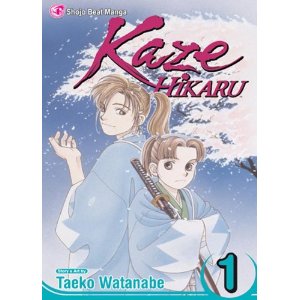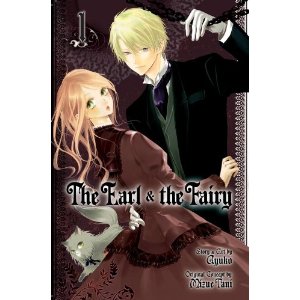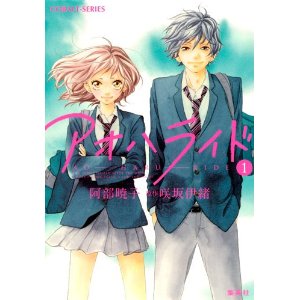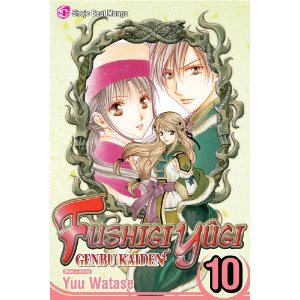Anna: For this discussion post for the Shojo Beat Manga Moveable Feast, I’m welcoming Laura from Heart of Manga and Lori from Manga Xanadu. Join us as we talk about Shojo Beat, the manga imprint (and sadly departed magazine) that has produced a wide variety of female-centric manga for discerning readers. I thought I would kick off the discussion by asking what everybody’s favorite Shojo Beat titles are?
Favorite Shojo Beat Titles
Laura: That’s a tough one because there are several I love! Hana-Kimi was my first manga I totally loved, so I guess now that it’s going through reprints I can count it. Skip Beat! would be my all-time favorite, with Kimi ni Todoke and Dengeki Daisy close behind.
Anna: It is tough because Shojo Beat puts out so many titles that often my favorite is whatever I’ve read most recently! But I’ll agree with you about Hana-Kimi being fabulous. I think Nana is a classic work, and of the titles currently being released I love Story of Saiunkoku and Dengeki Daisy.
Lori: I’m with you Anna, often my favorites are whatever I’ve read recently. Nana would have to be on my all time favorite though, as it was one of the titles that got me reading shojo seriously. The new release of Hana-Kimi has introduced me to that series, and I was love with it in an instant! I adore Story of Saiunkoku and Kimi ni Todoke, and really enjoy Dengeki Daisy as well. I’d add Beauty Pop and The Earl and the Fairy is starting to climb up the list as well! It’s really hard to limit the list since so many of them seem to strike a chord with me.
What Shojo Beat Title Would We All Avoid?
Anna: Are there any Shojo Beat titles that you feel less enthusiastic about? Generally a large stack of my reading list is Shojo Beat, but I have to admit I’ve never felt the urge to go back and reread Absolute Boyfriend, even though I love Yuu Watase’s other works.
Lori: There have definitely been titles I didn’t care for. I didn’t care to read Absolute Boyfriend, Crimson Hero, or Baby and Me when they were serialized in Shojo Beat magazine, and even less about them in collected books. I know this will probably get me some heat, but I didn’t care for Gentleman’s Alliance Cross or Vampire Knight. There was way too much melodrama in them for my tastes. Recently, I’ve tried Ai Ore and Black Bird. While both have had elements I liked, the overall “icky-ness” I felt from them keep me from following them regularly.
Laura: Hmmm. Must be something about Absolute Boyfriend. Hehe. Of all Shojo Beat titles I’ve read and reviewed, and I have covered a major chunk of the list, Absolute Boyfriend was the only one I have rated as “don’t bother reading.” I hated it. I think Hot Gimmick comes in second. While I liked the tension in the first few volumes of Black Bird, it really started to go sour in later volumes. Oh, and I could never get through Haruka:Beyond the Stream of Time because it felt too much like a Fushigi Yugi knock-off.
Lori: I couldn’t get through the one preview chapter of Hot Gimmick that was printed in Shojo Beat. So not a title for me. I liked Haruka: Beyond the Stream of Time though. I hadn’t read any of Fushigi Yugi then, though I’m not sure it would have made a difference to me. I like the “Neo Romances” that include Haruka and also La Corda d’ Oro. I have a weak spot for bishonen.
Anna: Ah, I’m planning on covering Gentlemen’s Alliance Cross and Vampire Knight for the manga moveable feast! Something about all the pretty art and melodrama appeals to my inner 13 year old! I do genuinely like Hot Gimmick because it is so much of a soap opera. I found that the later (second series) volumes of Ai Ore are almost an entirely different series, much more comedic and less icky. Are there any Shojo Beat titles that you think haven’t gotten the attention they deserved?
Underappreciated Shojo Beat Titles
Laura: Definitely some of the more historical series. I think Kaze Hikaru is a gem that not many know about. I discovered it last year and fell in love with the characters. Of course I seem to be partial to the “girl hiding as a boy” titles. Saiunkoku has a strong female protagonist that I would love for everyone to read about, but it doesn’t seem as popular as other series. I also think Yurara and Rasetsu aren’t as popular as they should with the supernatural elements that seem to be a huge fad in the past few years.
Anna: I LOVE Kaze Hikaru. I came around to it slowly, because I read the first few chapters in Shojo Beat magazine, enjoyed it but was underwhelmed, and then after I checked the first few volumes from the library I decided I had to collect the whole series.
Lori: Like you Anna, I started reading Kaze Hikaru in Shojo Beat, and felt just as underwhelmed. I’ve since read subsequent volumes but haven’t be captivated by it as a lot of others have. I’ve liked what I’ve read, but haven’t loved it. And I completely agree with you Laura about Yurara and Rasetsu. They have a good balance of strong female lead, comedy, and drama as well as the supernatural hook. Another historical series that didn’t get the attention it deserved is Red River. That title is almost crack-tastic in the way it can grab you and suck you into an exciting story and steamy romance!
Laura: I’m right with you on Red River, Lori. Although it’s a pre-Shojo Beat imprint title, it’s one of the first few manga series I read and loved and collected all 28 volumes. It definitely deserves an omnibus reprint and some hype like some of the other earlier series have been getting.
Anna: I’m slowly collecting Red River, because I didn’t read it as it was coming out. One of these days I’m going to go on a Red River binge! But we should swing back to the Shojo Beat imprint. Do you think that the magazine’s cancellation had much of an effect on the series that you try or your buying habits?
Shojo Beat Magazine and Buying Habits
Lori: It definitely did for me. I didn’t intend to subscribe to Shojo Beat. My one-month-old subscription to Animerica became a Shojo Beat sub, but after reading a few issues I kept it. Shojo Beat is what got me to read shojo manga, where before I scorned most “girly” or romance titles. I wouldn’t be the fan I am today without it, and wouldn’t have tried half the titles I did. I really miss the previews and spotlights that the magazine did. It not only helped me find new titles, but helped to convince me to check out older titles that I had missed.
Laura: I think the magazine is one of the reasons Shojo Beat thrived while other companies were struggling. I didn’t realize what was being published because I hardly saw ads for other companies. I think the magazine had a big influence over what I read, whether I realized it or not at the time. It was a great way to try out series and see how they fared.
Anna: I didn’t subscribe to the magazine, although I’d often buy it on the newsstand when I could find it. I agree that it was a great way of exposing readers to series that they wouldn’t normally try. The imprint seems to be doing fine without the magazine, as many Shojo Beat titles seem to be winding up on the NYT manga bestsellers list. What do you think of the more recent Shojo Beat series?
Recent Favorites
Laura: A Devil and Her Love Song, The Earl and the Fairy, and Jiu Jiu are the ones from this year. I really like The Earl and the Fairy with the supernatural and historical elements. The writing and art is great. A Devil and Her Love Song is a slice of life with a couple of really cute bishies. I like Maria Kawai as a character, and I find her approach to situations interesting. I’m not really sold on Jiu Jiu yet. In my review I stated that it was a little too icky for me in the sense that the wolf pups seem to be trying to ravish the main character.
Going back a little further, there are two series from last year I rather enjoy. Dawn of the Arcana is great. There’s fantasy and magic, with serious romantic tension. I also like The Legend of Princess Sakura with Tanemura’s gorgeously detailed art. Oresama Teacher is okay. It has great elements of humor and a quirky protagonist, but it’s not my favorite. Then there’s Ai Ore! I kind of have a love/hate relationship with that one. I like reading Shinjo’s smutty stuff, because she’s great at it. However I just can’t like the androgynous characters from Ai Ore! It’s often hard to watch. I have to laugh at it.
Lori: From this year, like Laura I loved The Earl and the Fairy, and I’ve just read A Devil and Her Love Song. I will be getting more of that series. Jiu Jiu I need at least another volume or two before I decide. I want to see where the series is going. The scene with Snow was a little weird, but I don’t see it becoming a usual thing. At least I hope not. Going back to last year, The Legend of Princess Sakura was the first Tanemura title I read that I really liked and have picked up subsequent volumes. I have the first two volumes of Dawn of Arcana, but haven’t read them yet. Oresama Teacher has been very hit or miss with me. I like Mayufu and Hagasawa, but just couldn’t stand Takaomi. I really didn’t like Ai Ore!. It was all the smutty stuff that turned me away actually, rather than the androgynous characters as I thought would.
Anna: I have a lot of fondness for Oresama Teacher, just because it is the only purely goofy shojo comedy series that I never find boring. I think that Mayu Shinjo is a national treasure for her smut-writing abilities, and while I didn’t care as much for the first few volumes of Ai Ore!, the later volumes tend to lean more towards the comedic instead of smutty. That being said, I’m looking forward to her upcoming series Demon Love Spell in the hopes it will be more like Sensual Phrase than Ai Ore!
Shojo Beat License Requests
Laura: What titles would you like to see Viz license?
Lori: Not an easy question, but off the top of my head, I’d like the sequel to St. Dragon Girl, St. Dragon Girl Miracle. And there are two titles from Kaori Yuki that I would love to read; the one volume Bloodhound about a girl and a host club vampire, and Ludwig Revolution, a Yuki take on fairy tales. There is a sequel to Ludwig Revolution, Ludwig Fantasia that seems just started last year, so I’ll add that after we get the first series.
Anna: I am really bad about license requests because the titles I want most have nothing to do with economic reality. I loved the non-Shojo Beat title Basara, and I would like to be able to read another of Yumi Tamura’s series like 7 Seeds, a look at a hazardous post-apocalyptic world inhabited only by a few humans. Since that is extremely unlikely to happen, I’d just like to see more titles aimed at older readers that straddle the line between shojo and josei like Nana.
Laura: Okay, Bloodhound sounds like fun supernatural story with vampires. I could go for that as well as the sequel to St. Dragon Girl. I think for Shojo Beat I’d like to see Ao Haru Ride by Io Sakisaka get licensed. That’s the same author as Strobe Edge that’s coming out here in the next month or so. I really would like to read Love So Life by Kaede Kouchi, but she is a fairly new mangaka. Hoshi wa Uta, or Twinkle Stars by Natsuki Takaya of Fruits Basket is another one. Akatsuki no Yona is a fantasy adventure series by Mizuho Kusanagi of Mugen Spiral/NG Life that I’d like to read as well. For josei I’d have to request Hapi Mari by Maki Enouji. I could keep going but that’s enough for now.
Anna: Thanks for joining me for this discussion, Laura and Lori!





